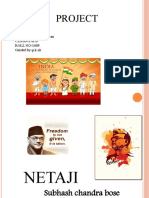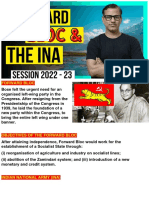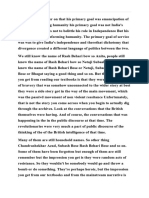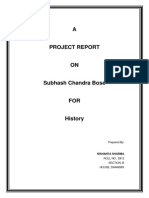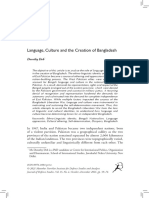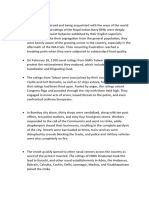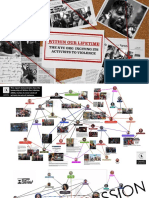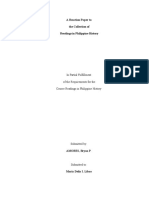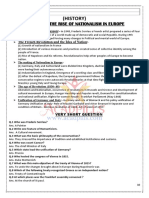From plus say to partition chapter 8, the turbulent 40s.
Notwithstanding the fact
that there was a grand convergence of multiple streams of protests at the
historical conjuncture of 1942, and that gave Congress immense political
legitimacy, it is still difficult to deny that contesting visions and agendas of
emancipation existed within India's national struggle against imperialism.
01:51:46
We may now turn to some such alternative visions before going into the story of the
final withdrawal of colonial rule. When the war broke out in Europe and the
Congress was still vacillating in its response, its related leader Subhash Chandra
Bose was arguing that the Indians were losing a rare opportunity for they must take
advantage of the Empire's weakest moment. He was convinced in 1939, when
disciplinary action was taken against him, that it was the result of right
consolidation, and now this hesitation, to initiate a mass movement against the
Raj, was because of the same write wing leaders who were out of touch with the new
forces and the new elements that Had come into existence in the last few years.
01:52:31
He therefore travelled alone across India to stir a movement but did not get much
enthusiastic response. Back in Bengal, he forced a link with a Muslim league and
decided to launch a civil disobedience movement to destroy the hallwin monument
that stood in Calcutta as a reminder of a black old tragedy, which most people
believed did never happen and was invented only to the memory of senator donor the
last independent ruler of Bengal. It was a campaign that had an obvious appeal to
the Muslims and thus could further strengthen the Hindu Muslim pact in Bengal.
01:53:09
But before it could start, he was arrested by the British on 3rd July 1940, under
the defence of India act. The homein monument was later removed, but both remained
incarcerated until he threatened to start a hunger strike in December. He was then
released unconditionally, but kept under constant surveillance.
01:53:31
In the meanwhile, more progressed in Europe and boss believed that Germany was
going to win. Although he did not like their totalitariism or racism, he began to
nurture the idea that the cause of Indian independence could be furthered with the
help of the Axis powers and started exploring various possibilities. Finally, in
the midnight of 16 to 17 January 1941, he fled from his Elgin road residence in
Calcutta, incluido as an upcoming Muslim.
01:54:02
He travelled to Kabul and then threw Russia on an Italian passport by the end of
March, he reached Berlin. Subah's boss met goebbles and Hitler in Berlin but did
not receive much help from them. He was allowed to start his Azad in radio and was
handed over the Indian pounds captured in North Africa to start an Indian region.
01:54:23
But nothing beyond that. Particularly, he could not get an Axis declaration in
favour of Indian independence and after German reverses at stanning rat, that
became even more difficult, but in the meanwhile, a new stage of action was being
prepared for him in Southeast Asia, where the Japanese were taking real interest in
the cause of Indian independence. India originally did not figure in the Japanese
policy of greater east Asia, for prosperity sphere, under which the Japanese
proposed to help Asians gain independence from Western imperialism.
01:55:00
But by 1940, Japan had developed an India policy and the following year sent major
for Jeevana to Southeast Asia to contact the expatriate Indians who were organising
themselves into the Indian independence leagues under the leadership of men, like
�Pritam Singh, then in December 1941. Capt. Mohan Singh, a young officer of the
Punjab regiment of the British Indian Army, who had surrendered to the Japanese in
the jungles of malaya, agreed to cooperate with fujivala to raise an Indian Army
with firms to March alongside the Japanese to liberate India in June 1942A united
Indian independence league.
01:55:40
Representing all Indians in Southeast Asia was born as a civilian political body,
having controlling authority over the Army. To cheer this body Raj Bihari Bose, a
veteran Bengali revolutionary, then living in Japan was flown in By September, the
enna was formally in existence. But its relationship with the Japanese was still
far from satisfactory.
01:56:05
As Japanese duplicity now became more than apparent. Gen. Tojo, the Japanese Prime
Minister made a declaration in the diet supporting Indian independence.
01:56:17
But beyond that, the Japanese were only prepared to treat Ena as a subsidiary force
rather than Anad army. As Mohan Singh insisted on autonomy and added status, he was
removed from command and Put under arrest rash biharni was tried to hold the banner
for some time, but he was then too aged for the task. By the beginning of 1943, the
first Ena experiment virtually collapsed.
01:56:45
As Mohan Singh had often mentioned to the Japanese, the Inna movement needed a new
leader and outside India, only one person could provide that leadership and that
was Subhash Chandra. Bose. The Japanese now seriously considered the proposition
and negotiated with the Germans to bring him to Asia at last after a long and
natural submarine voyage in May 1943, Bose, arrived in Southeast Asia and
immediately took control of the situation, with Japanese assurance of health and
equal treatment.
01:57:19
In October, he established a provisional Government of free India, which was
immediately recognised by Japan and later by 8 other governments, including Germany
and fascistitley. And he became the supreme commander of its army, the Azad In
falls, free India army or the Indian National Army, which recruited around 40000
men by 1945 and had a woman's regiment named after the legendary Rani of Jhansi of
1857 fame. The professional government declared gold on Great Britain and its chief
ambition was to March as an Allied army, with the Japanese through Burma to Imphal
in Manipur, and then to Assam, very Indian people were expected to join them in an
open rebellion to liberate their mother country, but they ill-fated.
01:58:10
In fall campaign. Which was finally launched on 8 March 1944 by Japan, southern
army, accompanied by 2 inner reginames, ended in a disaster. The reasons were many
as Joe's Libra enumerates them.
01:58:25
The lack of air power break down in the chain of command disruption of the supply
line, the strength of Allied offensive, and finally, for the enna lack of
cooperation from the Japanese The retreat was even more devastating, finally,
ending the dream of liberating India through military campaign. But Bose still
remained optimistic out of regrouping, and after Japanese surrender, contemplated,
seeking help from Soviet Russia. The Japanese agreed to provide him transport up to
mantleya, from where he could travel to Russia.
01:59:00
�But on his way on 18th, August 1945 at taehoku airport in Taiwan, he died in an air
crash, which many Indians still believe never happened. But if enough's military
campaign was over after the last valiant engagement at mount oppa in Burma, its
political impact on India was yet to unfold itself. After their surrender, the
₹20000 soldiers were interrogated and transported back to India.
01:59:29
Those who appear to have been persuaded or misled by Japanese or inner propaganda
classified as whites and grace were either released or rehabilitated in the Army.
But a few of them, at least the most committed and categorised as blacks, were to
be quote, martially. Not to try them would be to give indication of weakness and
tolerate reason would be to Put the loyalty of the Indian Army at risk.
01:59:57
So altogether, 10 trials took place and in the first and most celebrated one at Red
Fort in Delhi, 3 officials PK Seidl Gs and Shah Nawaz Khan were charged of treason,
murder and abdment of murder. The trial would take place in public as this was
expected to reveal. The horrors that these INR men had perpetrated, and that the
government hoped Would serve public opinion against them.
02:00:24
But as the events subsequently unfolded, the government, it seemed had completely
miscalculated the political fall out of the Ina trials. As the press censorship was
lifted after the war, the details of the enna campaign were revealed every day
before the Indian public and these officers appeared as patriots of the highest
order, not by any means threateners, and the demand for discontinuing the trials
grew stronger by the day. The Congress leader's many of them just released after
long inconsideration, since the quit India days could hardly ignore this issue that
so profoundly touched popular emotions.
02:01:05
The election was round the corner and the Inna trials could be an excellent issue.
Subah's boss might have been a relegade leader who had challenged the authority of
the Congress leadership and their principalees, but in death he was a martyred
Patriot, whose memory could be an ideal tool for political mobilisation. So the ICC
meeting in September 1945 decided to defend the accused in the Ina trial.
02:01:31
The misguided patriots and announced the formation of a defence committee
consisting of some legal luminaries of the day like these Bahadur Sapru, mullabhai,
Desai asafali and also Jawaharlal Nehru donning the barrister's gown after about a
quarter of a century In the subsequent days, as the election campaign set in Nehru
and other Congress, leaders addressed numerous public meetings with large
gatherings. And there to issues figured prominently, one was the government
accesses and the martls of 1942, and the other was in our trial.
02:02:08
The government, however, remained firm. The first trial opened on 5th November and
continued for 2 months, and in course of that time, India erupted into a mass
appeal as Nehru later described. It never before in Indian history.
02:02:25
He admitted had such unified sentiments, been manifested by various Divergent
sections of the population. There were many factors that led to this mass upsurge.
The trial took place at Red Fort, which appeared to be the most authentic symbol of
British Imperial domination, as here, took place an 1858 the trial of Bahadur Shah,
I the last Mughal emperor and the acclaimed leader of the 1857 revolt.
02:02:53
�Furthermore, as trial progressed, its reports appeared in the press, leading to
more awareness and to some extent, more emotionalization of the sacrifices made by
the Inna soldiers. All political parties like the Congress, socialists, a Ali dal
Unionist party justice party, Rashtriya Swayamsevak Sangh in the mahaspa and even
the Muslim league, wanted the trials to be discontinued. Individual communists
enthusiastically participated in the demonstrations, although their party
evascilated in its response.
02:03:28
And by a strange coincidence, the 3 accused belonged to 3 different religions, one
flintru, 1 sick and 1 Muslim, the demonstrations therefore showed signs of
remarkable communal harmony. Elina week was celebrated between the fifth and 11th
November. While the Ina day was observed on 12th November in cities across the
country.
02:03:52
People from all walks of life participated in the campaign attended protest
meetings, donated money to the Ina relief fund, closed shocks and other commercial
institutions, and in some places, refrained from celebrating Diwali. And the
movement touched even the remotest places like Kuru Baluchistan, an Assam Finance
erupted first on 7th November when the police opened fire on the crowd at the
protest demonstration in Madurai. Then between the 21st and 24th, November writing
broke out in various parts of the country, starting from Bose's own Calcutta.
02:04:31
Yeah, first of all, American and British military establishments were attacked, but
then the writing took a general antibritish tone with students clashing with the
police and being joined later by the striking taxi drivers and family labourers.
They exhibited unprecedented communal harmony with the demonstrators flying
simultaneously, the Congress league and Communist flags. Order could be restored
after 3 days, with 33 people dead and 200 injured.
02:05:02
The Calcutta riot was soon followed by similar demonstrations in Bombay Karachi
Patna, Allahabad, Banaras, Rawalpindi, and other places or in other words, all over
the country, the government's determination now wave her in the triumph, the
defence tried to argue that people fighting for freedom. Of their country could not
be tried for treason. But despite that, they were found guilty as charged, but the
commander chief remitted their sentence and set them free on 3rd January 1946.
02:05:36
The 3 officers came out of the Red Fort to a heroes welcome at public meetings in
Delhi and Lahore that celebrated a moral victory against the British, but it was
not all over yet. On 4th February, in another trial, Capt. Abdul Rashid, who
preferred to be defended by a Muslim league defence committee rather than by the
Congress, was sentenced to 7 years rigorous imprisonment.
02:06:03
It's sparked of another explosion in Calcutta between the 11th and 13th February
this time called initially by the student wing of the Muslim league, but later
joined by the members of the communism student federation and industrial workers.
Once again demonstrations, followed with Congress, leak and red flags, flying
simultaneously and large meetings were organised, where league Communist and
Congress leaders addressed The Crown. A general anti-British sentiment pervaded the
city, which was paralysed by transport, strikes industrial action and pitched
street battles with British troops.
02:06:42
�Order was again restored after 3 days of brutal depression that had 84 people
killed and 300 injured. 2A historian who participated in the demonstrations as a
student leader, the situation looked like an almost revolution. The fire soon
spread to east Bengal and a spirit of revolt affected other parts of the country,
as well as sympathetic protest, demonstrations and strikes, took place in
practically all major cities of India.
02:07:12
Since the middle of 1945, the British were expecting a mass up haven in India.
Anyway. But what really perturbed them was the impact of the Inna trials or the
loyalty of the Army, which in post quit India days, was their only reliable
apparatus of rule.
02:07:29
General occuline, the commander-in-chief limited the sentence of the 3 Ena
officers, because as he later explained the senior British officers, any attempt to
force the sentence would have led to chaos in the country at large and probably the
motini and the cent in the Army culminating in its resolution. The growing
political consciousness among the Army personnel during and after the war had
already been a cause of concern for the authorities. What further contributed to it
was the inner trial and the growing sympathy for the Inna, soldiers who were almost
universally regarded as patriots rather than treators.
02:08:08
The members of the raf, as well as some other army personnel in various centres,
openly donated money to the Ina relief fund, and on some occasion, attended protest
rallies in full uniform. In January 1946, the RIF men went on strike in support of
their various grievances, but what really posed a real grave challenge to the Raj,
was the open motini in the royal Indian Navy R in February 1946, it all started in
Bombay on 18th February when the naval ratings. In hms, talvan went on hunger
strike against bad food and racial discrimination.
02:08:48
Soon the rebellions spread to other naval bases all over India at the sunships on
the sea, where sympathetic strikes took place. At its peak, 78 ships, 20 short
establishments and 20000 ratings were involved. What was really remarkable was the
extent of fraternisation between the naval ratings and common people that was
visible during these few days in various cities of India, a phenomenon that had
immense revolutionary potential Bombay went on strike on 22nd, February in
sympathy, and here, public transport system was paralysed.
02:09:24
Roadblocks, were raised trains. Were burned, shops and banks were closed, and
industrial workers went on strike. Here, through the navy rebels used 3 flags
simultaneously as they went round, rampaging the city.
02:09:39
A Maratha bachalan was called in to bring peace to Bombay by 25th February. The
city was quiet again, but by then 228, civilians were dead and 1046 were injured.
Similar hathas took place in Karachi on 23rd February and in Madras, on the 25th,
in both cities, several ratings and civilians died in police firing.
02:10:03
Sympathetic, but less violent 1 day strikes were also reported from trinapoli and
Madurai worker strikes to place in Ahmedabad and Kanpur the arrive men and some
army personnel also went on strike at different centres. There was another words
enough reason for the government to be perturbed. The Arron motini was, however
short-lived, but it had dramatic psychological repercussions.
�02:10:33
Although it did not immediately lead to an open revolt in the Indian Army, such a
possibility could never be ruled out. An official inquiry commission later revealed
that majority of ratings were politically conscious and were profoundly influenced
by the Ina propaganda and ideals. The sympathetic strikes in the air force, an army
indicated very clearly that the Indian Army was no longer the same sharp sword of
repression, which the British could use as before, if a popular outburst of the
1940 to proportions, took place again, to what extent this revelation forced upon
the British a change of policy in favour of transfer of power is debatable.
02:11:15
For the Congress, which could alone give leadership to such an upsurge, was not
interested in the radical and violent potential of the happenings of 19:45 to 19:46
to its leadership, the EO officers were patriots, but misguided, they could be
taken back into the Congress as Sardar. Patel announced at a meeting in Calcutta
only if they Put their swords back into the scabbar. When the rn Modi need took
place socialists like Aruna Asaf Ali sinbadhized, with the rebels, but Gandhi
condemned the violence and Patel persuaded the ratings to surrender to pertain the
preferences were clear discipline in the Army cannot be tampered with We will want
a be even in free India.
02:12:02
In other words, for Congress, the days of struggle were over. It was now looking
forward to its new career as the ruling party, so after the word, it was clear to
everyone that the British would like to hand over power to Indian sooner, rather
than later, leaders like Nehru were anticipating in late 1945, that Britain would
leave India within 25 years. Soon it was time to negotiate for a peaceful transfer
of power.
02:12:31
But if Congress was not prepared to risk another battle in 19:45 to 19:46, the
communists were not only did they participate actively in the urban riots in
Calcutta and Bombay where they had by now prepared a solid base among the
industrial workers, they now organised some militant peasant movements in various
parts of India involving the poor peasants and sharecroppers. Ever since the
seventh world Congress of the Communist international in Moscow gave its verdict in
1935 in favour of a United France strategy in India, the Indian Communist started
functioning through the Congress in Bengal.
02:13:12
The externalists once incarcerated for violent activities, started Communist
propaganda and sought to capture the Bengal provincial Kisan Sabha B.P. KS. Through
this organisation, they started mobilising the Pizza tree in northern Eastern and
Central Bengal, around radical agrarian issues such as payment of tolls and village
marks collected by the Union boards, illegal aparts, taxes imposed by the
zamindar's abolition of this minerary system.
02:13:41
And finally, the sharecroppers demand for a Twitter's share of the produce. By
1940, the bpks was almost totally under the control of the communists, and its
membership had shot to 34000 from near 11003 years ago, Communist activities and
Kisan mobilisation picked up further momentum once the ban on the CPI was lifted in
1942. Although the Quit India Movement temporarily stole the wind of its sales, the
popularity of the bbks does not seem to have been affected at all by May 1943.
02:14:17
It had 124872 members, one reason for the popularity of the communists by mid 1943
and subsequently was perhaps the afterback of the devastating Bengal famine of that
year. Amal, the same is inclined to pick a figure around 3 million as the death
�toll of the Bengal comine. All greena, foot, Put it somewhere between 3.5 and 3.8
million, while the more recent estimate of Tim, listen and a route Maharatna, puts
it at to point 1 million as the figure for excess deaths caused by the Bengal
famine.
02:14:53
Even if we go by the most conservative estimate, the famine was a catastrophe of
such magnitude that history of the subcontinent had never known before. Bengali,
public opinion was unanimous that it was a man-made famine. There were a few
natural factors, of course, like a devastating cyclone in Midnapore, but that alone
did not cause the famine.
02:15:17
As greenhouse points out, the per capita entitment of rice was gradually going down
in Bengal over a long period In 1943, it reached a crisis point due to multiple
factors such as the breakdown of an already vulnerable rice marketing system, which
have for long, remained completely unsupervised and uncontrolled, leading to
hoarding and speculation. What are did to this for a government procurement policy
that prioritised official and military requirements over local needs of subsistence
and the wartime stresses like the denial policy, the refugee influx from Burma into
Chittagong, and the disappearance of imported rice from Burma, the relief
operations failed miserably, while the government trying to save Calcutta at the
expense of the countryside, the malwadi relief committee and the Hindu mahasabha
relief committees targeted only the middle classes.
02:16:12
The peacentry, the worst sufferers of the famine, had nowhere to go, it is true
that this unusual scarcity of food caused by the exorbitant price of rice, that
shot beyond the reach of the ordinary people did not cause any food riot in Bengal,
instead the violence as green of argues turned inward. And downward, destroying all
conventional relationships of patronage and dependency The communists responded
adequately to the food situation, they held meetings at various parts of Bengal,
criticising the government's food policy and undertook through bpks and Mahina
samiti's extensive relief work in the villages of the presidency and rajshahi
divisions.
02:16:56
I In north and Central Bengal, where they became instantly popular among the poor
peasants and sharecroppers in 1943, the bpk's membership reached 83160 the highest
among all the provisional kisaan sabhas in the country. Although they preferred a
conciliatory policy at this stage under the people's VA. strategy, the involvement
of poor peasants, often got bpks, engaged in clashes with zamindars, train dealers
and other vested interests.
02:17:30
This gradually prepared the ground for the debaga movement in support of a long-
standing demand of the sharecroppers for total's share of the produce, instead of
the customary half. At the end of the war, in view of the rising popular unrest,
the Communist party too, started shifting grounds and move towards a more diligent
line. In a resolution adopted on 5th August 19, 46, it declared that the Indian
freedom movement has entered its final phase.
02:17:59
So what was needed was a joint front of all patriotic parties to stage a national
democratic revolution that would ensure all power to the people. Against this
Patro, in September 1946, the vpks decided to launch the debhada movement, and soon
it spread to a wide region where peasants harvested the paddy and took it to their
own command storehouse and then invited the landlords to come and take their 1/3
share. Although north Bengal districts were the worst affected by this
�sharecropper's agitation, contrary to popular notion as Adrien, Cooper has shown
their Bhaga movement touched a wider region covering almost every district in
Eastern Central and Western Bengal.
02:18:45
Here, the peasants carved out their tabhaga, ilaka or liberated zones where they
instituted alternative administrations and arbitration codes. The Muslim league
ministry then in power in Bengal, responded by proposing a baldal bill in January
1947, apparently conceding the share croppele's demand but it was soon dropped
because of opposition from within the Muslim league and from the Congress. From
February, the movement began to spread rapidly, provoking an angry response from
the government.
02:19:18
The peasants bravely fought police repression and resisted landlords latials, but
soon it became such an uneven battle that the bpks decided to retreat, although in
some pockets peasants resolved to continue without their leaders. One may observe
in this pleasant movement, some of the earlier features like the strength of
community ties that predominated previous peasant struggles. The sharecroppers
belonged mainly to tribal and delete groups such as the Raj bunches and nambulas,
and the bpks had built its organisation on the foundation of such community
structures.
02:19:56
Sukhda Bose has however, noticed in this movement of the late colonial period
greater class consciousness, concerns about individual rights and proponents of
economic issues that often tended to fracture older community loyalties as
rajapanese and Muslim sharecroppers, often did not feel inhabited in attacking.
Rajbani and Muslim jyotidas. But it was not a revolutionary movement, either
claiming land for the dealers, which remained only a distant goal to cement a
delicate alliance between various classes of Pizza tree.
02:20:30
It was a partial movement that gave presidents to the sharecropper's demand. It was
therefore participated by the sharecroppers and poor peasants in large numbers,
supported and sometimes led by the middle peasants. Its impact on Bengal agrarian
relations was far-reaching But above all, it showed that in a political environment
already vitiated, by communal riots, the peasants were still capable of aligning
across the religious divide.
02:20:59
However, it was also true that the st peasants on other occasion, participated in
communal riots. Class and community were thus so intimately intertwined in peasant,
consciousness and identity that it is analytically difficult to separate one from
the other. Such elements of continuity suggest that these recent responses were
more congenital instigated by their immediate grievances, ideological mediation and
historical environment rather than indicative of any sharp turn in colonial peasant
history and this is a pattern that we will observe in other Communist ledmass
movements as well.
02:21:38
In Western India, the Maharashtra Kisan Sabha took up the cause of the vanlily
tribal agricultural labourers in umbalgaon and Dahanu talukas in Thana district.
Their main grievance was against forced labour weight performed for landowners and
moneylenders, at a time when prices of daily necessities had been pushed up by war.
In 1944, the valleys of Umbergaon on their own, staged and unsuccessful strike to
demand a minimum daily wage of 12 on hours ₹,1 is equal to 16 annas for
agricultural work, such as grass cutting and tree felling.
�02:22:15
The strike failed, but here after the kisaan Sabha started organising the wallais,
and at a conference in May 1945 decided to launch a more prolonged movement for the
abolition of forced labour and claiming a minimum wage of 12 on hours. The movement
spread quickly in the Umbergaon taluka, where forced labour were stopped and
deadsers, were released and then it spread to the nearby the Hanu taluka with
similar results. In October as the grass cutting season approached, the movement
entered its second phase, when the Kisan saba called for a strike to claim a
minimum wage of rupees to 28 for cutting 500 pounds of grass.
02:22:55
The landlords responded with intimidation court cases and appeals to district
administration for help. In one incident, on 11th October when the police opened
fire on a peaceful gathering, 5 others died defending the red flag, which had by
now become the symbol of their unity and an icon of deliberation. The strike was
nearly complete and forced many landlords, though not all to yield to their
demands.
02:23:23
But that did not in the vaguelee struggle in October 1946, the movement was again
renewed this time with an additional demand for a minimum daily rate of ₹,1 to 4
for forest work, which the timber companies were not prepared to offer the near
total peaceful strike, continued for over a month and finally on 10th November, in
an agreement with the Kisan Sabha, the timber merchants association agreed to pay
the minimum wage. The movement thus ended in a great victory for the tribal
valleys, who were mobilised by the Kisan Sabha around specific economic grievances.
02:24:01
This did not mean, however, that their community identity played a less important
role as the red flag had now acquired a magical significance to become a new iconic
representation of their tribal solidarity in the south, the communists, entrant
themselves and establish their undisputed sway over peasant unions in the villages
of north. Malabad, during the early 40s, when the region suffered from acute food
shortages and nearby fine conditions. During the people's war faced, they preferred
a conciliatory policy sought to renegotiate the agreeing relations and try to
construct what delete Menon has called a congentual community of landowners and
cultivators.
02:24:44
But this fragile truce broke down in 1946 in a context of postwar stress and
scarcity as the landlords, became more aggressive in collecting rent and kind
evicting, defaulting peasants and asserting their rights over wastelands and
forests. The Kenya Communist party also allowed a more diligent line for the
peasants. At this stage, it was never that violent as in Bengal, but throughout the
19:46 to 19:47 period peasant volunteers here fought with the landlords and the
malabas special police to prevent collection of rents at times of scarcity to stop
the sale of rice in the open markets for excess profits and to bring wastelands
under cultivation.
02:25:27
However, it was further south in the princely state of Travancore that the most
violent popular upsurge, led by the communists, took place in October 1946 at Punna
pravided near the industrial city of alipa. Here, the growth of coal industry after
World War, I saw the emergence of a large working class and their unization under
Communist leadership by mid 1900 40s. In 1946, the Government of the princely state
in view of the impending withdrawal of the British started working towards
asserting the independence of travancourt by imposing an undemocratic constitution,
allegedly based on American model.
�02:26:09
While the local Congress seemed to be conciliatory to the divan, the Communist
party decided to make it an issue. As this situation coincided with food scarcity
and a lockout in the coir industry, the workers were exasperated and were joined by
agricultural workers, botwin, fishermen and various other lower occupational
groups. On 24th October, they attacked a police southpost at ponaura, killing 3
policemen and thereafter, violence spread rapidly to other areas.
02:26:41
The government retaliated the next day when the military attack and killed 150
Communist volunteers at a camp in violin and another 120 ath ministry The movement
then died down quickly, as the Communist leaders went underground and repression
was unleashed. Robin Jeffrey has argued that the revolt had nothing at all to do
with communal or caste issues and was a product of an organised disciplined working
class. But the fact remains that about 80% of the participants belonged to the low-
ranking, but socially organised ejamacaste, and this certainly provided an element
of solidarity among the ranks of the Rebels.
02:27:24
It wasn't Hyderabad, another southern princely state that the most prolonged and
radical peasant movement on the Communist leadership, took place from mid 1946.
Yeah, agrarian relations under the autocratic rule of the Nizam reassemble in the
worlds of Dean dhandle, a page from medieval feudal history where the jagirdas
patadars, landowners, deshmukhs and Deshpande's revenue. Collectors held complete
sway over the rural society.
02:27:55
Further, to that commercialization of agriculture and introduction of cash, crops
brought in the soccers, moneylenders, growing land alienation, and increasing
number of agricultural labourers. Particularly in the 1940, the falling prices
continuing from the depression years affected the small landowing patas and rich
peasants, while poorer peasants, resented the oppressive practice of forced labour
of vicinity and food scarcity of the postpart period This created the groundwork
for an armed pleasant insurrection, which took place in Telangana, I the 8 Telugu,
speaking districts of Hyderabad, with the nearby Andhra Delta of the British rule
Madras presidency, providing a secure base.
02:28:41
Here, the communists have started mobilising the peacetry since mid 1930 through
certain front organisations such as the Andhra conference in Telangana and the
Andhra mahazma in the Delta region. The movement started in Nalgonda district in
July 1946 with an attack on a notorious landlord, and within a month, it spread to
a wide region in Nalgonda baangal and kammam districts. The demands of the movement
were many as they were meant to forge a class alliance between the Kamma and ready
small patata, and rich, pleasant leadership of the Communist movement and the
poorer untouchable, Mala madiga, and tribal peasants and landless labourers, who
were gradually being drawn into the movement.
02:29:25
These included demands for wage increases and a pollution of wealthy illegal
extractions, eviction, and recently imposed grain Levy. The movement at this
initial stage was, however, less organised and most cosmetic in nature in June
1947, the Nizam announced that after the withdrawal of the British Hyderabad would
maintain its independence and would not join the Indian union. As this meant the
continuation of the antigated medieval rule, the local Congress decided to launch a
satyagraha and the communists, despite their reservations, joined in and hosted
national flags in various parts of the state.
�02:30:07
But the alliance soon broke down as the movement was not going anywhere, while the
majli idhaan muslimin an outfit of the minority Muslim anistocracy, now recruited
its own armed banks, called the razakars, and with the endorsement of the Nizam
unleashed a reign of terror in the Telangana, countryside. To resist depression,
the peasants and the Communist leadership now began to form volunteer jurila's
squads called the began to seize wastelands and surplus land from big landlords and
redistribute them and formed village republics also be it's in areas considered to
be liberated zones.
02:30:46
When on 13th September 1948, the Indian Army entered Hyderabad it meant the end of
the Nizam's dream of independence and his army police at the deserted banks
surrendered immediately. But this did not mark the end of the Telangana
insurrection, which now entered its second phase as a Communist party, despite some
opposition from within, decided to continue the struggle, which was claimed to be
helding a people's democratic revolution in India. The Indian Army also launched
its police action against the Communist guerrillas, and the uneven battle continued
until October 1951, when the movement was formally withdrawn.
02:31:28
The Telangana movement was perhaps the most widespread, most intense and most
organised peasant movement in the history of colonial India, according to one
estimate, the movement involved peasants in about 3000 villages, covering roughly a
population of 3 million in an area of about 16000 square miles. It mobilised 10000
ville, squad members and about 2000 Guerra squads and managed to redistribute about
1 million acres of land. About 4000 Communist cadre, a peasant volunteers were
killed while about 10000 were jailed and many more thousands harassed and total
This, your scale also makes it clear that there were more complexities in the
movement than these statistics apparently suggest Gandey has shown that it was
based on very broad class and communal alliances, which often proved vulnerable.
02:32:25
The class alliance began to flounder, after the seizure of land began and the
landscilling question was settled in favour of rich peasants. Also, in occupying
land there was more enthusiasm about Commons, land baseline and forests than about
the surplus land of the landlords. All the lit groups formed the sizable section of
the participants.
02:32:48
Their role as galondite assets was mainly a subordinate one as the Communist
leadership, almost routinely ignored the issues of caste operation and
untouchability. In all these recent movements organised by the communists and Kisan
sabhas, there is evidence of autonomous peasant initiative, either in taking action
before the middle class leaders actually arrived or identifying the latter's
cautionary directives. What these configurations therefore indicate the existence
of widespread popular discontent among all classes of peacentry in post-war, India,
which the Communist party decided to channelize, albeit in certain specific
regions.
02:33:30
And if the peacentry was restive, the industrial working classes had become
restless too because of the inflation and postwar retriment. The wave of strikes in
Indian industries reached its peak in 1946, when more than 12 million man days were
lost, and this figure was more than 3 times higher than in the previous year. And
apart from industries, workers struck at the post and telegraph department and in
the South Indian railways and Northwestern railways.
02:34:01
�This general environment of this coin did not, however, lead to any nationwide mass
movement. But that does not mean that all those moments of rebellion were
meaningless or those hundreds of lives were sacrificed in vain. After the war, it
was clear that the British were going to leave India.
02:34:20
But that decision one may argue was to a large extent, prompted by this environment
of inquieto. There was a growing realisation that now it would be more difficult to
deal with a mass upsurge or to hang on to the Empire by Force as disaffection, had
also trickled into the Army ranks. Hence, there was a greater urge to negotiate for
an order transfer of power so that India might at least remain within the
Commonwealth, and the British economic and strategic interests were protected.
02:34:52
We may now turn to that story if you like this video. So please do night, share
this video and hit the subscribe button. From plus's a to partition.





